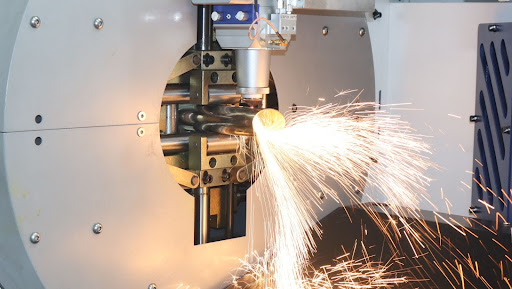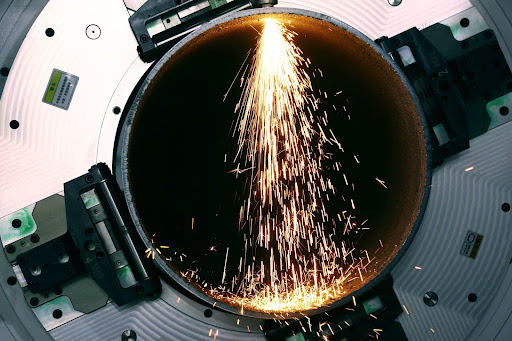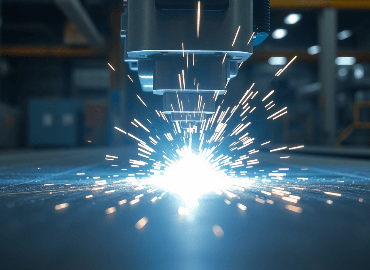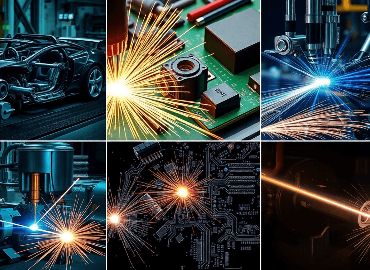Table of Content
- Myths and Misconceptions About Fiber Laser Cutting
- Advantages of Fiber Laser Cutting Over Other Methods
- Conclusion
- FAQs
Fiber laser cutting has transformed the manufacturing industry, offering precision and efficiency that other cutting technologies often can't match. However, despite its growing popularity, there are still many laser-cutting misconceptions surrounding their use. These Fiber laser cutting myths can lead businesses to overlook this highly effective technology, missing out on the potential benefits.
Myths and Misconceptions About Fiber Laser Cutting

Fiber laser cutting is often misunderstood as being limited to very few applications. Some may even believe that fiber laser cutting is only suitable for a few industrial applications, but it's not true. Here are the most common myths and misconceptions about fiber laser cutting.
1. Fiber Laser Cutting is Too Expensive
One of the most common beliefs about laser cutting is that it's prohibitively expensive. While the upfront Cost of Purchasing a Fiber Laser Machine can be significant, this laser-cutting technology offers long-term savings. Fiber lasers are highly efficient, reducing the need for consumables like gas, which is required in other cutting methods. Additionally, their low maintenance and high precision lead to less material waste, contributing to overall cost savings in the long run.
2. Fiber Laser Cutting is Only Suitable for Thick Materials
Many people believe that Fiber lasers are only effective for cutting thick materials. In reality, Fiber laser cutting machines are highly versatile and can cut through both thick and thin materials with ease. From thin sheets of aluminum for aircraft bodies to thicker steel plates for structural components, Fiber lasers are capable of handling a wide range of thicknesses, making them a flexible solution for industries.
3. Fiber Laser Cutting Produces Low-Quality Edges
There is a persistent belief that Fiber laser cutting produces rough or low-quality edges. However, these laser-cutting misconceptions stem from older technologies. Modern Fiber lasers are designed to produce clean, smooth edges with minimal post-processing. Their precision far surpasses that of traditional cutting methods like mechanical saws or plasma cutting, improving laser cutting machine reliability.
4. Fiber Laser Cutting is Slow
Cutting speed myth is another often said, but it's not true. In fact, Fiber lasers are known for their speed, especially when cutting thin materials. The speed of cutting depends on the thickness and type of material, but advanced laser technology has optimized for faster operation. This allows manufacturers to improve productivity and reduce lead times.
5. Fiber Laser Cutting is Dangerous to Operate
Safety concerns loom large in the realm of laser technology, prompting a critical examination of the safety measures in Fiber laser cutting machines. However, modern laser cutting machine reliability cannot be questioned as they are equipped with numerous safety features, including enclosed designs, automatic shut-offs, and protective barriers. Operators are also trained to follow strict safety protocols, ensuring that the cutting process is safe and controlled. When used correctly, Fiber laser machines are no more dangerous than any other industrial equipment.
Laser Technologies offers Fiber Laser Marking Machines for efficient and precise marking solutions on various materials like metals, plastics, and ceramics. With advanced fiber lasers and precise beam control, these machines provide exceptional results, offering permanent, high-contrast marking, precise engraving, and unmatched speed.
6. Fiber Laser Cutting Can Only Cut Metals
Although Fiber lasers are commonly associated with cutting metals, they are not limited to metallic materials. Fiber lasers can cut a diverse range of materials, including plastics, wood, ceramics, and even delicate fabrics, highlighting their versatility across industries.
Want to know more about cutting different materials? Explore how Fiber Laser Welding Machines deliver precision across industries!
7. Fiber Lasers Have a Short Lifespan
Some people believe that Fiber laser cutting machines wear out quickly and require frequent replacement. However, Fiber lasers are known for their durability and long lifespan. With proper maintenance, a Fiber laser can last for years, surpassing the longevity of other types of lasers.
8. Fiber Laser Cutting is Difficult to Learn
Another Fiber laser cutting myth is that operating a Fiber laser machine requires extensive training or technical expertise. In reality, many modern Fiber lasers are equipped with user-friendly interfaces, ensuring that operators of all skill levels can easily navigate and utilize the technology. With proper training and support, even beginners can quickly become proficient in Fiber laser cutting.
9. Fiber Laser Cutting Wastes Material
The precision of Fiber laser cutting minimizes material waste, making it one of the most efficient cutting methods available. By using high-precision technology, Fiber lasers can cut complex shapes with minimal kerf (the width of the cut), resulting in better material utilization and reduced waste.
10. Fiber Laser Cutting Consumes a Lot of Power
Many assume that Fiber lasers consume large amounts of energy, but this is not the case. Fiber laser technology is actually one of the most energy-efficient cutting methods available. Compared to other laser cutting methods, Fiber lasers require significantly less power to operate, making them a more environmentally friendly choice.
Advantages of Fiber Laser Cutting Over Other Methods
Fiber laser cutting offers several key advantages compared to other cutting technologies, making it a popular choice across industries. These advantages make Fiber laser cutting the preferred choice in many industries.
1. Energy Efficiency
One of the biggest advantages of Fiber lasers is their energy efficiency. Compared to older laser types, Fiber lasers use significantly less power. This not only leads to reduced operating costs but also makes the technology more environmentally friendly.
CO2 lasers generally consume more power to perform similar tasks, making them more costly over time. Plasma cutting and waterjet cutting also require more energy due to their reliance on consumables and additional processing elements.
2. Low Maintenance Costs
Fiber lasers have fewer moving parts and require less maintenance than CO2 lasers or mechanical cutting machines. This leads to less downtime and lower repair costs.
CO2 lasers require more frequent mirror alignment and gas refills, increasing upkeep expenses. Waterjet machines need regular replacement of abrasive materials and frequent nozzle maintenance.
3. Minimal Material Waste
Fiber lasers produce clean cuts with minimal kerf (the width of the cut), resulting in less wasted material. This precision allows manufacturers to optimize material usage by cutting intricate shapes closely, minimizing waste, and maximizing material efficiency.
Mechanical cutting typically results in more material waste due to larger kerf sizes and tool wear. Waterjet cutting, while precise, can result in material degradation from the abrasive used in the process.
4. Enhanced Safety Features
Fiber laser cutting machines are designed with advanced safety features, including enclosed systems, automatic shut-off mechanisms, and protective barriers. This helps to ensure the safety of operators while minimizing risks associated with high-powered lasers.
CO2 lasers also have safety measures but may pose greater risks due to the need for gas handling and open design. Mechanical cutting methods pose risks related to blade wear and potential breakage, increasing the danger for operators.
5. Faster Cutting Speeds
When it comes to speed, Fiber lasers outshine many other cutting methods. The technology allows for high-speed cutting, especially when dealing with thin materials. This efficiency can significantly reduce production times, leading to higher throughput for manufacturers. Fiber lasers can be up to 3 times faster than traditional CO2 lasers when cutting thin metals.
Ready to take the next step? Find out How to Buy a Fiber Laser Cutting Machine and simplify your operations!
Conclusion
Fiber laser cutting has revolutionized the way industries approach precision cutting, offering a range of benefits from cost savings to enhanced productivity. While many myths and misconceptions persist, it’s clear that Fiber laser cutting is a safe, efficient, and versatile technology that can handle various materials and applications.
As the technology continues to evolve, it's likely that Fiber laser cutting will become even more widely used in the years to come. Laser Technologies offers a diverse range of laser solutions, specializing in Fiber laser technology, for various industries like manufacturing, automotive, and aerospace, ensuring high precision and efficiency.
Transform your cutting process with our advanced laser solutions. Start today by exploring our Fiber Laser Marking Machine Solutions and enhance your production!
FAQs
1. Is Fiber laser cutting suitable for small businesses?
A: Yes, fiber lasers come in different sizes and price points, making them accessible to small businesses as well.
2. How does fiber laser cutting compare to traditional methods?
A: It provides higher precision, reduced material waste, and faster cutting speeds compared to traditional methods like mechanical cutting.
3. Can fiber laser cutting be used in automotive industries?
A: Absolutely, fiber lasers are widely used in the automotive industry for creating precise and intricate parts.
4. How can I ensure safety when operating a fiber laser cutting machine?
A: Always follow manufacturer guidelines, use protective gear, and ensure the machine’s safety features are properly activated.






